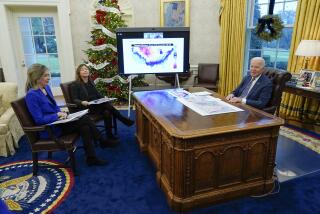Workers need his gift, not his gift shop
- Share via
IT’S BEEN A MONTH of funerals for the Golden State -- four literal and one figurative.
Since early December, California has buried some of its great and good: Ellen Stern Harris, the “mother” of the Coastal Commission Act; Bill Robertson, a working man who championed the worker as head of Los Angeles County’s labor federation; and two city councilmen -- Ernani Bernardi and Marvin Braude, who were vigilant protectors of L.A.’s public money, public spaces and public health.
Then, this week, there’s been The Times’ series describing how the heirs to Cesar Chavez’s name and legacy have, metaphorically, shoveled dirt onto his coffin.
According to the stories, the United Farm Workers has evolved, in the fashion of a “CSI” television series, into spinoffs. The Times detailed a broad-spectrum operation that has become, in effect, Cesar Inc.: interlocking nonprofit agencies that raise millions and have spread into lobbying and real estate and other unions’ affairs. Organizing farmworkers, meanwhile, has slipped down the priority ladder.
At least the leaders were honest when they snipped out of the preamble of the UFW constitution the part about the people who have “tilled the soil, sown the seed and harvested the crops” and about struggling “as long as it takes” to build a union for them.
Today, only a few thousand farmworkers belong to Chavez’s union. But the tales of suffering farmworkers still raise the big bucks. And why are so many tens of thousands still suffering? Why are there laudable laws on the books but not in the fields, where workers don’t know about them and officials don’t always enforce them? Isn’t it the first and last mission of the UFW to organize and protect workers?
Cesar Inc. obviously isn’t happy with The Times’ stories, but they’re not easy reading for the rest of us either. The strikes and grape boycotts of the 1960s and ‘70s led a lot of middle-class people, young and old, to think, “Hey, whaddya know -- even I can make a difference.” After the bus boycotts and sit-ins across the South, Chavez brought his own methods to bear on California agriculture. He showed middle America that it could join in at home. When you could help the campesinos with something so simple as passing up the fruit plate, why not join the struggle?
Once millions of Americans saw the union make real progress -- minimum wages and labor protections and contract negotiations and a ban on the cortito, the short-handled hoe -- they figured, “Well, that’s settled. What outrage do we take on next?”
Of course, it’s never settled. Race and gender matters, labor, education and health -- it’s a constant avalanche that keeps tumbling down on our heads, and like Sisyphus, we have to keep pushing the rocks back uphill again. No one’s surprised to look up and see the bad guys shoving the stones down; it’s when the good guys aren’t all down at the bottom pushing up that it’s so dispiriting. And it just gives aid and comfort to the people who can’t wait to fold their arms and say, “See? Told you so. Unions -- they’re just in it for the money.”
Chavez’s identity became the UFW’s identity, which was as risky as it was potent. A movement that runs on its leader can go off the rails without him. One Times story recalled a celebration by farmworkers who had just finished an English course. They put on a slide show that ended with, “The union is not Cesar Chavez. The union is the workers.” Minutes later, the union’s co-founder demanded to know who had put the students up to such heresy.
These days, every idea, even a tried-and-true one, must slug it out in the marketplace. The National Chavez Center in the Tehachapis uses the man to convey the message, just as presidential libraries do, as the King Center in Atlanta does. Virtually every gift-shop item sold there bears Chavez’s name or face. A special-edition box of Kellogg’s Hispanic Heritage Month Corn Flakes with him on it, and signed by his widow, goes for $20. If Gandhi had been assassinated six years ago instead of nearly 60, would his heirs have felt pressed to open some Gandhi Peace Center, with a gift shop selling souvenir dhotis like Gandhi’s, which could double as hand-towels to lend your bathroom an air of tranquillity and peace? Maybe so.
The national Martin Luther King Jr. holiday is Monday. Chavez’s California holiday, his birthday, comes on March 31. Chavez died almost 13 years ago. I covered his funeral, followed his coffin and wondered then, was it a hail and farewell, or a new beginning? At the funeral, a man at Chavez’s coffin noticed a grandfather lift his grandson high to see Chavez’s dead face. “See this man?” the old man told the boy, “I am going to tell you about him someday.”
It may be that an important man’s real heirs aren’t always the ones who bear his name or run the charities. That little boy, or boys and girls like him, may be the true Chavistas, who inherit his legacy by reviving it.
More to Read
Inside the business of entertainment
The Wide Shot brings you news, analysis and insights on everything from streaming wars to production — and what it all means for the future.
You may occasionally receive promotional content from the Los Angeles Times.











